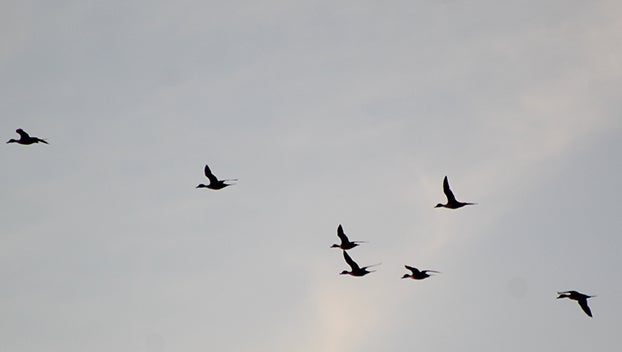Waterfowl Aerial Survey: January 18 to January 24, 2022
Published 12:08 pm Tuesday, February 1, 2022

- A flock of pintail ducks fly over The Swamp area of St. Catherine Creek National Wildlife Refuge at the Sibley Unit. (Hunter Cloud | The Natchez Democrat)
|
Getting your Trinity Audio player ready...
|
JACKSON — The fourth and final MDWFP aerial waterfowl survey of the season was flown January 18 – 24, 2022. As has been the case the entire fall and winter, wetland habitat availability across the Mississippi Delta was below normal levels for this time of year. Although shallow, managed water has incrementally increased with each survey since November, the Mississippi River and interior Delta river systems have remained below their flood stages.
These river systems have provided little or no natural, overbank flooding throughout the hunting season and river levels have fallen over the past week. As usual, wetland habitat availability generally increased as survey transects moved further northeast in the Delta region during this survey. In contrast to previous years, estimates for all groups of ducks declined from their early
January peaks. Estimates for mallards, other dabbling ducks, diving ducks, and total ducks all remained below their respective long-term averages for late January (Tables 1 and 2). However, it is worth noting that Mississippi experienced several days of freezing temperatures during this survey, which may have shifted ducks to “non-traditional” wetlands such as large reservoirs to the east of the Mississippi Delta.
Mallards and other dabblers made up nearly 80% of all duck observations, while diving duck estimates declined after peaking in December. Mallards were the most abundant species observed, followed by gadwall and northern shovelers, and a notable increase in northern pintails was observed. Scaup and ring-necked ducks were the most abundant diving duck species observed. The northeastern portion of the Delta held the greatest abundances of mallards, other dabbling ducks, diving ducks, and total ducks overall.
Mallards and other dabblers were most observed using flooded agriculture fields, which is common for late January, as well as anytime temperatures reach below the freezing mark for several days in a row. As usual, most diving ducks were observed using aquaculture ponds and deep, permanent water bodies. In agricultural fields, ducks were commonly observed in large complexes with multiple flooded fields.
Contrasting to the previous surveys, ducks were more evenly distributed across available wetland habitat, which is typical of late-season behavior. Observations of light geese (snow, blue, and Ross’) and greater white-fronted geese (commonly called specklebellies) remained high, particularly in the northern half of the Mississippi Delta region.
The final week of Mississippi’s regular waterfowl hunting season has arrived, with the final day coming on Monday, January 31. However, hunters are reminded to take advantage of the additional waterfowling opportunities for youth, veterans, and active military personnel February 5 – 6. Abundant hunting opportunities also remain during the light goose conservation order February 1 – 4 and February 7 – March 31. Local weather conditions are predicted to be cool and clear in the coming days, followed by a warmup on Sunday and Monday to wrap up the regular season.






